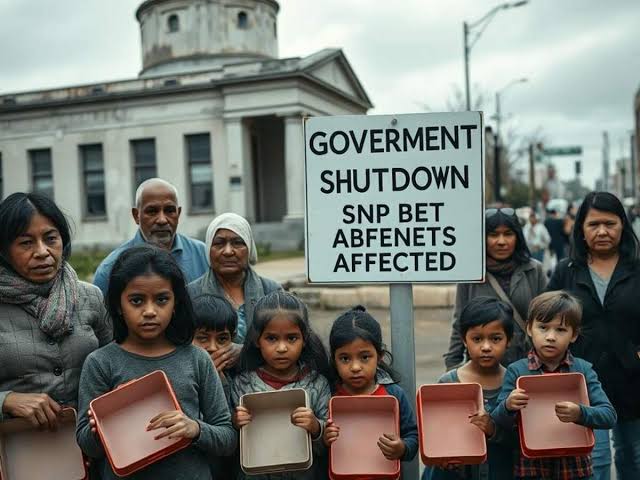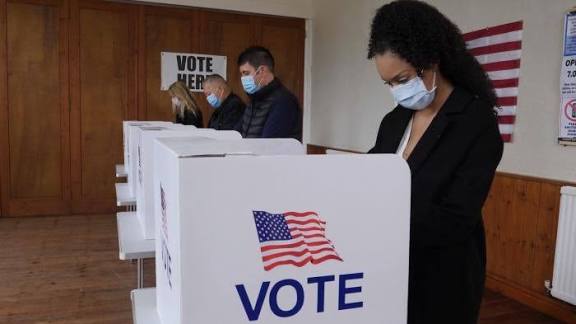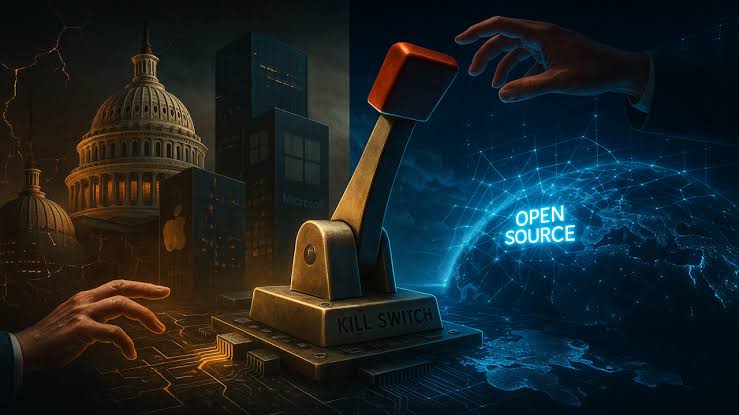Shutdown Panic: SNAP Funding Freeze Puts 45 Million at Risk

Congress couldn’t pass a standalone bill to reopen the government or fund SNAP, so its customers ultimately saw their benefits disappear. Today we will discuss about Shutdown Panic: SNAP Funding Freeze Puts 45 Million at Risk
Shutdown Panic: SNAP Funding Freeze Puts 45 Million at Risk
A deep sense of unease is spreading across the United States as the federal government shutdown continues with no resolution in sight. At the center of the storm is a crisis touching the daily lives of millions: the potential collapse or reduction of the Supplemental Nutrition Assistance Program (SNAP). SNAP, the country’s largest anti-hunger program, supports more than 40 million low-income Americans. With funding withheld or partially frozen, the possibility of delayed, reduced, or eliminated benefits has caused what many are now calling “shutdown panic.”
For those who rely on SNAP, the stakes are painfully tangible. They are wondering: Will there be food next month? Will benefits arrive at all? What happens if the shutdown continues?
This article examines the root causes of the crisis, the human and economic fallout, the political battles behind the scenes, and the consequences if SNAP remains underfunded. It also explores broader questions about how shutdown politics threatens America’s most vulnerable.
What Is SNAP and Why Is It So Essential?

SNAP, once known as food stamps, is managed by the U.S. Department of Agriculture (USDA). It provides monthly assistance through an EBT card that works like a debit card at grocery stores. More than 40 million Americans—around 1 in 8 people—receive help each month.
SNAP is not a fringe program. It helps:
Millions of children, many of whom live in households struggling to provide consistent meals.
Elderly Americans on fixed incomes.
People with disabilities who cannot work or earn limited income.
Working poor families who earn too much for traditional welfare but too little to reliably afford groceries.
Studies consistently show that SNAP lowers food insecurity by around one-third. It reduces hunger, improves nutrition, supports child development, and helps stabilize families during emergencies, job losses, and inflation. It also injects billions into the economy, particularly benefiting small grocers and local farms.
Because the program is so large, any disruption—especially one affecting tens of millions—has immediate national consequences.
How the Shutdown Triggered a SNAP Emergency
1. The Federal Shutdown Blocked Regular Funding
SNAP depends on annual budget approval or continuing resolutions to maintain benefits. When the government shuts down, that flow is interrupted. Unlike some mandatory federal programs, SNAP cannot continue indefinitely without congressional approval.
When the current shutdown began on October 1, the USDA could only rely on limited leftover funds. Once those ran dry, the program faced the possibility of stopping benefits entirely.
2. Contingency Funds: A Lifeline With Limits
To manage emergencies like natural disasters, the USDA maintains a contingency reserve of roughly $5–6 billion. However, the administration initially declined to use these funds for regular monthly benefits during the shutdown, arguing that they were not intended to cover political standoffs.
This decision sparked backlash from state governments, anti-hunger groups, and lawmakers who argued that withholding food assistance during a national emergency is unacceptable. Many said the administration was choosing not to help millions of families even though money technically existed.
3. Legal Battles Forced Partial Action
States sued the federal government, claiming that the USDA had a duty to use contingency funds to keep families fed. Judges in multiple states ordered the USDA to release part of the emergency funding.
The result:
The USDA agreed to release $4.65 billion for November.
But benefits would be only 50% of their usual amount.
New SNAP applicants would not receive benefits without an approved federal budget.
For many families, half benefits simply aren’t enough. And for newly unemployed or struggling individuals who need food assistance urgently, being locked out of the program entirely could be devastating.
Who Is at Risk?
The Scale: Over 40 Million People
While exact numbers vary slightly, the risk encompasses more than 40 million Americans. Some estimates place the figure as high as 45 million when including those who cycle in and out of the program monthly.
This includes:
Millions of Children
Children are among the most vulnerable. SNAP is often the difference between hunger and adequate nutrition during critical years of physical and cognitive development.
Seniors and People With Disabilities
Many older adults and those with chronic illnesses rely heavily on SNAP. Cuts to benefits may force them to choose between food, medicine, or utilities.
Low-Income Workers
SNAP is common among workers in service industries, retail, and caregiving roles. Cuts mean that people who are working full-time still may not be able to afford groceries.
Rural Communities
Rural Americans disproportionately rely on SNAP, given higher poverty rates and limited access to high-paying jobs.
The Human Impact: Real Lives, Real Consequences
The panic surrounding the freeze is not theoretical. For millions, SNAP is already budgeted down to the last dollar. With only half benefits—or possibly none—people are preparing for painful compromises.
Families Rationing Meals
Parents often skip meals so their children can eat. With reduced benefits, this sacrifice may become even more common.
Chronic Illness and Diet-Dependent Conditions
Individuals with diabetes, heart disease, or hypertension may be unable to buy the foods necessary to maintain their health, risking medical emergencies.
Mental Health Strain
The constant fear of not having enough to eat can heighten anxiety, depression, and stress—especially for parents trying to shield their children from the turmoil.
New Applicants Turned Away
People who lost jobs during the shutdown or are facing economic hardship may now be denied SNAP because the program cannot process new recipients without congressional funding.
Economic Ripple Effects
A SNAP freeze or reduction does not just affect individuals—it affects local economies and public systems.
1. Reduced Consumer Spending
SNAP injects billions into the U.S. economy each month. A freeze could remove as much as $5 billion in grocery spending in just one month. Small and rural grocery stores depend heavily on SNAP dollars.
2. Food Banks Overrun
Charitable food assistance networks are bracing for a surge. Many food banks are already operating at capacity after years of inflation and increased demand. They cannot replace billions of dollars in missing federal food aid.
3. Higher Healthcare Costs
Malnutrition worsens chronic conditions. Emergency room visits may spike if people cannot afford adequate diets.
4. Strain on State Budgets
Some states have stepped in with emergency programs to keep their residents fed. But these stopgaps are expensive, and many states lack the financial resources to sustain them long-term.
Political and Ethical Firestorm
The SNAP crisis has become a flashpoint in the broader shutdown debate.
State Governments Push Back
Governors and attorneys general in numerous states have accused the federal administration of negligence. Some states have launched emergency programs to distribute food assistance using state funds.
Congressional Conflict
Hundreds of lawmakers have urged the USDA to restore full benefits. Others argue that the federal government should not dip into reserves intended for natural disasters.
The Moral Debate
At the heart of the controversy lies a moral question:
Should access to food—a basic human necessity—be subject to political negotiation?
Critics argue that withholding food aid from millions is not a fiscal strategy but a form of cruelty. Supporters of strict appropriations rules say the administration must uphold the law and preserve emergency reserves for future disasters.
The ideological divide has deepened as the shutdown drags on.
Historical Context: This Has Happened Before—But Never at This Scale
Past shutdowns, such as the one in 2018–2019, put strain on SNAP but did not stop benefits entirely. Back then, Congress had set aside specific contingency funds.
This time, no such special preparation was made, leaving SNAP more vulnerable than in previous shutdowns.
Combined with inflation, higher food costs, and widespread economic instability, the current crisis is unprecedented.
Possible Outcomes: What Could Happen Next?
1. Congress Passes a Budget or Continuing Resolution
This would restore full SNAP benefits immediately, stabilize the system, and allow new applicants to join.
2. Another Court Order Forces Full Funding
Judges may intervene again, expanding funding beyond 50% benefits.
3. States Keep Filling the Gaps
Some states may continue emergency food-aid efforts, though this could deepen state-level budget crises.
4. Community Organizations Mobilize
Local charities will play a crucial role but cannot match the scale of SNAP.
5. Worst Case Scenario: SNAP Exhausts Its Reserve
If the shutdown continues and no additional funds are released, SNAP may be unable to issue further benefits. This would be catastrophic for millions.
Long-Term Implications
If SNAP collapses under the shutdown, the aftermath could reshape welfare policy permanently.
Policy Reform
Lawmakers may revise how mandatory programs are financed during shutdowns, possibly exempting SNAP from future political deadlocks.
Stronger Safety-Net Infrastructure
States and nonprofits may build more robust partnerships and rapid response systems.
Greater Public Awareness
This crisis has revealed how essential SNAP is—not only for hunger prevention but for economic stability and public health.
Conclusion: A Crisis That Should Never Have Happened
The shutdown has exposed the fragility of America’s safety net and the degree to which millions rely on federal systems to meet basic needs. Food insecurity is not a partisan issue—it’s a human one. The possibility that millions could go hungry because of a political standoff is alarming, unprecedented, and avoidable.
SNAP was designed to prevent hunger. It was built to support children, families, seniors, and the vulnerable. Allowing it to collapse or weaken during a shutdown is not just a bureaucratic failure—it is a moral one.
The question now is not merely how quickly funding can be restored but whether the nation will allow food assistance to be used as political leverage in the future. For the 40–45 million Americans who depend on SNAP, the answer could determine whether they face hunger tomorrow.
How useful was this post?
Click on a star to rate it!
Average rating 0 / 5. Vote count: 0
No votes so far! Be the first to rate this post.
About the Author
usa5911.com
Administrator
Hi, I’m Gurdeep Singh, a professional content writer from India with over 3 years of experience in the field. I specialize in covering U.S. politics, delivering timely and engaging content tailored specifically for an American audience. Along with my dedicated team, we track and report on all the latest political trends, news, and in-depth analysis shaping the United States today. Our goal is to provide clear, factual, and compelling content that keeps readers informed and engaged with the ever-changing political landscape.




